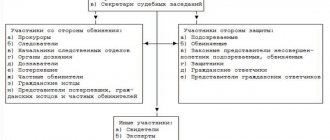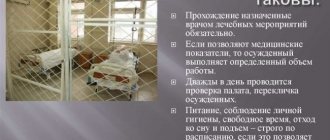New edition of Art. 178 Code of Criminal Procedure of the Russian Federation
1. The investigator examines the corpse with the participation of a forensic expert, and if his participation is impossible, a doctor. If necessary, other specialists may be involved in examining the corpse.
2. Unidentified corpses are subject to mandatory photography and fingerprinting. Unidentified corpses are also subject to mandatory state genomic registration in accordance with the legislation of the Russian Federation in the manner established by the Government of the Russian Federation. Cremation of unidentified corpses is not permitted.
3. If it is necessary to remove a corpse from a burial place, the investigator issues an order for exhumation and notifies close relatives or relatives of the deceased about this. The resolution is mandatory for the administration of the relevant burial site. If close relatives or relatives of the deceased object to the exhumation, permission to carry out it is issued by the court.
4. Exhumation and examination of the corpse are carried out with the participation of the persons specified in part one of this article. An examination of the corpse may be carried out before the initiation of a criminal case.
5. Expenses associated with the exhumation and subsequent burial of the corpse are reimbursed to the relatives of the deceased in the manner established by Article 131 of this Code.
Article 178 of the Code of Criminal Procedure of the Russian Federation. Examination of the corpse. Exhumation (current edition)
1. An examination of a corpse may be part of an examination of the scene of the incident (and be carried out before the initiation of a case), area, home or other premises. At the same time, its features established by the commented article must still be observed. It is not a violation of the law to document the examination of a corpse in a separate protocol. Inspection of the corpse as an independent investigative action is carried out when it was not possible to examine it at the place of discovery or when the corpse was discovered as a result of a search (Part 16 of Article 182) and removed from the burial site.
2. The actions of the forensic expert during the examination are additionally regulated by the Instructions for organizing and conducting expert research in the forensic medical examination bureau, approved by Order of the Ministry of Health of Russia dated April 24, 2003 N 161. The question arises: should a narrowing interpretation of the term “be used?” forensic medical expert”, meaning by him another participant in the process - a specialist (in the sense of Article 58 of the Code of Criminal Procedure) in the field of forensic medical examination? When answering it, it should be borne in mind that the commented article does not talk about examining the scene of the incident, but specifically about examining the corpse. But this type of inspection as such can be carried out only after the initiation of a criminal case. By adopting the new Code of Criminal Procedure of the Russian Federation (2001), the legislator unambiguously expressed his legal position by replacing the term “specialist in the field of forensic medicine”, previously used in Part 1 of Art. 180 of the Code of Criminal Procedure of the RSFSR, for the term “forensic medical expert” (Article 178 of the Code of Criminal Procedure of the Russian Federation). This approach can be given a completely rational explanation - it is assumed that, when starting to examine a corpse, the investigator should already order a forensic medical examination and, in order to take into account as completely as possible all significant circumstances during the latter, involve a forensic expert to participate in the examination of the corpse, i.e. e. at the earliest possible stage of its research. Such an approach does not give the law enforcement officer the right to resort here to a narrowing interpretation of the term “forensic expert”, because the literal interpretation can be replaced by some other type of it (narrowing or expanding; widespread or restrictive, correctional, etc.) only when the literal interpretation leads to absurdity, not allowing any rational explanation (the so-called golden rule of interpretation of legal norms). The opinion of the legislator should be respected, and when he excludes any conditions and characteristics from the content of a norm, or, conversely, when he supplements it with certain new conditions or characteristics, the law enforcer should not present this norm in such a way as if it still implies the previous legal content . However, if the examination of the corpse takes place as part of the examination of the crime scene, carried out before the initiation of a criminal case, then it must be recognized that at present it is not an expert who can participate in it, but only a specialist (in the field of forensic medicine). In this case, the rules of Art. 178, and Art. Art. 58, 168, 177 Code of Criminal Procedure of the Russian Federation.
———————————
See: Manukyan A.G., Smirnov A.V. Interpretation of legal norms. M.: Prospekt, 2008. P. 37 - 41, 68.
3. Exhumation covers cases of removal of a corpse from places of official burial only. Considering that the Code of Criminal Procedure does not classify exhumation as an urgent procedural action (Part 5 of Article 165), exhumation can be carried out without judicial permission if: a) the deceased has no relatives. On the concept of relatives, see comment. to clause 4, 37 art. 5; b) obtaining the consent of relatives (for example, in the form of a mark on the exhumation order); c) there is evidence that the relatives were notified in advance about the exhumation and did not express objections within a sufficient time. If relatives object, the exhumation of the corpse is carried out by a court decision, adopted in the manner provided for in Art. 165 of the Code of Criminal Procedure, and after a decision to initiate a criminal case is issued.
Comment source:
Ed. A.V. Smirnova “COMMENTARY ON THE CRIMINAL PROCEDURE CODE OF THE RUSSIAN FEDERATION” (ARTICLE BY ARTICLE), 5th edition
SMIRNOV A.V., KALINOVSKY K.B., 2009
42. INSPECTION OF THE CORPSE AT THE SITE OF DISCOVERY
An external examination of the corpse at the place of its discovery is carried out by an investigator with the participation of witnesses, a forensic expert,
and if his participation is impossible,
a doctor.
If necessary, other specialists may be involved in examining the corpse.
Unidentified corpses are subject to mandatory photography and fingerprinting. Cremation of unidentified corpses is not permitted. If it is necessary to remove a corpse from a burial site, the investigator issues an order for exhumation
and notifies close relatives or relatives of the deceased. The resolution is mandatory for the administration of the relevant burial site. If close relatives or relatives of the deceased object to the exhumation, permission to carry it out is issued by the court (Article 178 of the Code of Criminal Procedure of the Russian Federation).
Forensic physician at the scene of the discovery of the corpse
identifies signs that allow one to judge the time of death, the nature and mechanism of injury, and other data that is important for investigative actions; advises the investigator on issues related to the external examination of the corpse at the place of its discovery and the subsequent conduct of a forensic medical examination; assists the investigator in detecting traces similar to blood, semen or other biological secretions of a person, hair, various substances, objects, tools and other objects, and facilitates their seizure; draws the investigator's attention to all the features that are important for a given case; gives explanations to the investigator about the actions he is performing.
The results of the inspection of the scene of the incident and the corpse, as well as the start and end time of the inspection of the corpse, are recorded in the protocol of the inspection of the scene of the incident,
compiled by the investigator (Article 180 of the Code of Criminal Procedure of the Russian Federation).
The protocol describes all the actions of the investigator, as well as everything discovered during the inspection in the sequence in which the inspection was carried out, and in the form in which what was discovered was observed at the time of the inspection. The protocol lists and describes all items seized during the inspection. The protocol must also indicate at what time, in what weather and what lighting the inspection was carried out, what technical means were used and what results were obtained, what objects were seized and sealed and with what seal, where after the inspection the corpse or objects of significance to the criminal case.
The formulation of records related to the description of the corpse, traces similar to blood, on behalf of the investigator, can be made by a forensic physician, who has the right to make comments and additions to be included in the protocol. After reading, the protocol is signed by the participants in the inspection of the scene of the incident, including a doctor who is a specialist in the field of forensic medicine (Article 166 of the Code of Criminal Procedure of the Russian Federation).
Accounting for unidentified corpses
Family and fingerprint records Read more: Records of unsolved crimes by method of their commission
5. Accounting for unidentified corpses
The object of this type of accounting is unidentified corpses (including skeletonized and dismembered). Corpses are considered unidentified when the identity of the deceased has not been established. According to Part 2 of Article 178 of the Code of Criminal Procedure of the Russian Federation, unidentified corpses are subject to mandatory photography and fingerprinting. In addition, special signs, other anatomical features, as well as clothing and shoes, and items carried with him are photographed. If necessary, a verbal portrait can be drawn up. Cremation of unidentified corpses is not permitted. If the corpse remains unidentified during the investigation, it is subject to burial, but not cremation, regardless of the final results of the investigation. Otherwise, the possibility of subsequent examination of cadaveric remains will be excluded, if the need arises.
The registry office located at the place where the corpse was found or at the location of the emergency hospital is notified of the death of an unidentified person.
For an unidentified corpse, a similar card is filled out, which indicates when and where it was discovered, the time and causes of death, investigative measures taken to establish its identity, all the anatomical features of the corpse, special features (including birthmarks, tattoos, etc.) are displayed in detail. etc.), data on clothing, shoes, personal belongings. On the reverse side there are fingerprints and photographs taken according to the rules of identification photography.
If necessary, specialists in the field of portrait and fingerprint identification are involved. To establish the identity of an unidentified corpse, methods of plastic reconstruction of the intravital appearance from the skull and computer modeling are used.
Identification cards entering the file cabinet of unidentified corpses are checked against the files of missing persons and wanted persons.
6. Accounting for stolen items and animals
Registration of stolen items and animals is carried out at the central and regional levels. The obligatory objects of accounting under consideration at the regional level are things taken into account at the federal level. The full list of categories of relevant documents and things to be recorded in regional information centers is determined by orders of the Ministry of Internal Affairs, the Main Internal Affairs Directorate, the Internal Affairs Directorate of the constituent entities of the Russian Federation, the Department of Internal Affairs, and internal affairs bodies at sensitive facilities.
At the central level, the following accounts operate:
— accounting of stolen and confiscated documents of national circulation and numbered items;
— accounting of wanted and ownerless vehicles;
— accounting of stolen items of special value;
— accounting of stolen items that have special historical, scientific, artistic or cultural value.
A centralized record of stolen and seized documents and numbered items is maintained in order to ensure the search for stolen items and to establish the ownership of seized documents, items with individual inventory numbers, and to assist in solving crimes related to their theft.
Stolen and confiscated numbered items, in particular cold steel, including throwing and pneumatic weapons, are placed on centralized records at the State Information Center of the Ministry of Internal Affairs of Russia; numbered documents, including passports of citizens of the Russian Federation and forms of passport and visa documents of strict accountability; license plates and securities in connection with the commission of grave and especially grave crimes, including when registering with the federal authorities persons who are the objects of registration of the AIPS "ABD - Center".
The grounds for registering stolen, seized documents and numbered items with regional and federal registration are decisions to initiate appropriate criminal cases.
To describe each numbered item and document placed on regional (local) and federal records, a special information card (IPC - B) is used.
Numbered items (documents) are registered with the Information Center within 7 days from the receipt of information about the theft, and are removed from local registration only upon their written submission to the regional Information Center in the following cases: detection or identification of the license plate item or document; termination of a criminal case due to the absence of an event or corpus delicti or after the expiration of the statute of limitations; the expiration of two years from the moment of seizure of a document or thing whose ownership has not been established; solving a crime. The basis for removing wanted items and documents from federal registration is the IPC-B card, which is sent by the regional IC to the State Information Center of the Ministry of Internal Affairs of Russia within 15 days after their removal from local registration.
Centralized registration of wanted vehicles is intended for collecting, systematizing, storing, processing and issuing information about wanted vehicles and vehicles whose ownership has not been established that have a manufacturer's license plate. The formation and maintenance of this accounting is carried out using the Autopoisk AIPS in a unified system of centralized accounting at the federal and regional levels in the interests of law enforcement agencies of the Russian Federation and CIS member states.
The AIPS "Avtopoisk" database contains information about vehicles wanted by internal affairs bodies, prosecutors, customs authorities, security authorities, courts and tax authorities.
As part of the AIPS "Avtopoisk", the GIC interacts with the operational accounting of the AIPS "Rozysk" of the Main Directorate of the State Traffic Safety Inspectorate of the Ministry of Internal Affairs of Russia, created in the interests of the traffic police departments (GAI). In addition to all the information about wanted vehicles contained in the AIPS "Avtopoisk", the AIPS "Rozysk" also contains information put on operational records by the traffic police departments in the manner regulated by special regulatory legal acts.
Wanted cars and trucks, buses, trailers for trucks, tractors and self-propelled vehicles for road and construction work, both domestic and foreign made, and at the regional level - also trailers for cars are subject to registration in the AIPS "Avtopoisk" at the federal level. and tractors, motorcycles, scooters and sidecars.
The basis for centralized registration of operational information (i.e., those that were received before the issue of initiating a criminal case was resolved) is a statement or report of theft, misappropriation of a vehicle without the purpose of theft, as well as involvement in the commission of a crime.
Within the framework of the Autosearch AIPS, requests from internal affairs bodies, other law enforcement agencies of Russia and CIS member states are executed, as well as requests received from foreign countries through Interpol,
Relevant services to traffic police departments (GAI) are carried out within the framework of AIPS “Rozysk”.
The execution of requests from internal affairs bodies (police) of the CIS member states is carried out on the basis of the Agreement on the relationship of the Ministries of Internal Affairs in the field of information exchange (1992).
Centralized registration of stolen items that have special historical, scientific, artistic or cultural value is aimed at ensuring the search for these items and assisting in solving crimes related to their theft. In the State Research Center of the Ministry of Internal Affairs of Russia it is implemented on the basis of the Antikvariat AIPS.
The objects of this accounting are:
— historical values, including those related to historical events in the lives of peoples, the development of society and the state, the history of science and technology, as well as those related to the life and activities of government, political, public figures, thinkers, scientists, literature, and artists;
— objects and their fragments obtained as a result of archaeological excavations;
- paintings and drawings are entirely handmade on any basis and from any materials;
— original sculptural works, including reliefs, from any materials;
— original artistic compositions and installations from any materials;
— artistically designed religious objects, in particular icons;
— engravings, prints, lithographs and their original printed forms;
-works of decorative and applied art, including artistic products made of glass, ceramics, wood, metal, bone, fabric and other materials;
- products of traditional folk arts and crafts;
— components and fragments of architectural, historical, artistic monuments and monuments of monumental art;
- ancient books, publications of special historical, artistic, scientific and literary interest;
— rare manuscripts and documentary monuments;
— archives, including photo, film, video archives;
— unique and rare musical instruments; antique firearms and bladed weapons;
— postage stamps, other philatelic materials;
-ancient coins, orders, medals, seals and other collectibles;
— rare collections and specimens of flora and fauna of interest for mineralogy, anatomy and paleontology;
- other movable items, including copies that have historical, artistic, scientific or other cultural significance, as well as those taken under state protection as monuments of history and culture.
Modern souvenirs and cultural items of mass, mass production are not subject to accounting.
The grounds for centralized registration in the AIPS “Antiques” are decisions to initiate a criminal case regarding the theft of these items, as well as reports from the Interpol National Central Bureau of foreign states or the Interpol General Secretariat about the theft of such items received by the Interpol National Central Bureau in Russia.
For each stolen item, a special identification card is drawn up, which is used both to describe and register the item, and to adjust accounting, deregister and execute requests.
In case of theft of items of special historical, scientific, artistic or cultural value, identification cards are filled out by the investigator who decides to initiate a criminal case; in other cases - by an employee of the internal affairs agency or customs carrying out an operational inspection. A copy of the card remains in the verification material, criminal or operational search case. The original card, sent within the prescribed period to the territorial information center for registration, is accompanied by a photograph or sketch of the item.
Information centers for inquiries about stolen items can provide both specific identification data and general statistical information.
Family and fingerprint records Read more: Records of unsolved crimes by method of their commission
Information about the work “Hand Traces. Criminal registration"
Section: State and Law Number of characters with spaces: 78402 Number of tables: 0 Number of images: 0
Similar works
Criminal registration system
46408
0
0
..., as well as vehicles whose ownership is not established. A. Accounting for missing persons, unidentified corpses and unknown patients[1]. The accounting of the named objects of criminal registration is carried out by three independent, but interacting file cabinets. The registration and identification documents in the files are arranged in chronological order according to the time of disappearance of the missing persons...
Traces of human hands and their use in fingerprinting
116560
0
0
...) odor traces from objects by evaporation and condensation of substances forming such traces. At this stage, a method of forensic examination of human scent traces was developed and tested using testing odor carriers and signals from detector dogs as research tools. Using standard samples, the problem of monitoring and deciphering the signal behavior of the dogs used was solved. ...
Forensic registration
53593
0
0
..., data about which is contained in forensic records. 4) Providing reference and guidance information to operational search, investigative and judicial authorities Based on the purposes of criminal registration, it can be considered a kind of information system that collects and processes information about crimes, persons and objects involved in them, and transmits this ...
Automated evidence registration system
102196
4
19
... of an object, it is allowed to present their casts obtained using polymer masses. Chapter 2. Statement of the problem 2.1 Goal of development The main goal of the developed automated system for registration of material evidence is to ensure the transfer to computer technology of the vast majority of production functions related to registration, accounting and storage of items, ...






